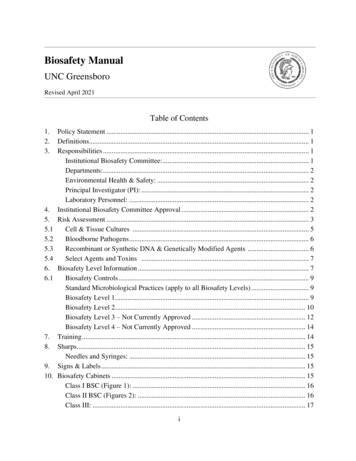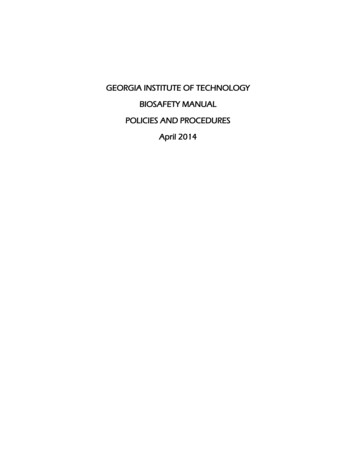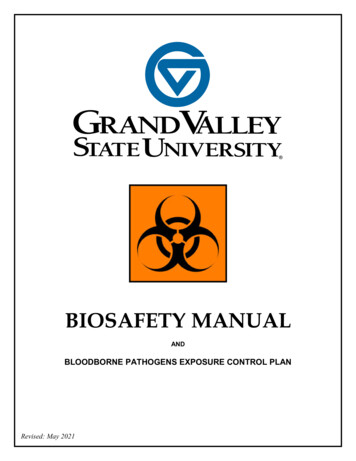
Transcription
BIOSAFETY MANUALANDBLOODBORNE PATHOGENS EXPOSURE CONTROL PLANRevised: May 2021
Table of ContentsI.Purpose and Scope. 4A. Definitions . 4II. Roles and Responsibilities. 6A. GVSU Institutional Biosafety Committee . 6i. Membership . 6ii. Responsibilities. 6iii. Conducting IBC Meetings . 7iv. Conducting IBC Meetings . 7B. Biosafety Officer . 8C. Principal Investigator/Laboratory Supervisor/Clinic Supervisor . 8III. Biosafety Approval Procedures . 10A. Biological agents or potentially biologically hazardous material . 10B. Human and Nonhuman Primate Blood and Tissue . 11C. Recombinant DNA . 12i. Covered Recombinant DNA . 12ii. Exempt Recombinant DNA . 12D. Select Agents . 13IV. Training . 14A. Biosafety Training . 14B. Bloodborne Pathogen Training . 14V. Personal Protection . 15A. Personal Protective Equipment . 15B. Medical Restrictions . 15VI. Working Safely with Biohazardous Agents . 16A. Standard Safety Procedures . 16B. Warning Signs and Labels . 17C. Biosafety Cabinets . 17D. Decontamination . 18i. Heat . 18ii. Liquid Decontaminants. 18iii. Vapors and Gases . 19VII. Infectious Waste Management Plan . 20VIII. Emergency Procedures. 23IX. APPENDIX . 24Grand Valley State University Exposure Control Plan. 24POLICY STATEMENT . 24CONTENTS . 24DEFINITIONS . 24PROGRAM ADMINISTRATION . 25EMPLOYEE EXPOSURE DETERMINATION . 26METHODS OF IMPLEMENTATION AND CONTROL . 26PERSONAL PROTECTIVE EQUIPMENT (PPE) . 26HOUSEKEEPING . 27LABELS . 27HEPATITIS B VACCINATION . 282
POST-EXPOSURE EVALUATION AND FOLLOW-UP . 28EMPLOYEE TRAINING . 29RECORDKEEPING . 30GVSU Biosafety Application . 333
I.Purpose and ScopeGrand Valley State University is committed to ensuring the safe handling, storage, and disposalof infectious agents and potentially biohazardous materials used by faculty, staff, and students inresearch and academic activity at the University. The purpose of this manual is to provide thenecessary procedures, guidance and information for the safe use of biohazardous or potentiallybiohazardous agents at Grand Valley State University (GVSU). Biohazardous materialsaddressed in this manual and of interest to the Institutional Biosafety Committee include thefollowing:1. Infectious agents or potentially biologically hazardous material (Risk Group 1 orunknown).2. Recombinant DNA3. Biological agents listed by National Institutes of Health in Risk Group 2, 3 & 4.4. Human and non-human primate tissue and blood5. Select agents and biological toxins identified by the Centers for Disease Control.This manual contains procedures for acquiring authorization to use, purchase, and possessbiohazardous agents; procedures for procurement of materials; safety precautions to follow whenworking with biohazards; emergency procedures for handling accidents involving biohazardousagents; and procedures for requesting the disposal of biohazards. All other appropriateregulations and guidelines (radiation, chemical, occupational safety, etc.) must also be followed.This document serves as a guide for GVSU compliance with the following regulations andguidance documents:-NIH Guidelines for Research Involving Recombinant or Synthetic Nucleic AcidMolecules (NIH Guidelines)CDC Biosafety in Microbiological and Biomedical Laboratories (BMBL) 5th EditionOSHA's Bloodborne Pathogens Standard (29 CFR 1910.1030)Michigan Department of Environment, Great Lakes, and Energy Medical WasteRegulatory ActA. DefinitionsBiological Agent: Biological agents include bacteria, viruses, fungi, other microorganisms andtheir associated toxins. They have the ability to adversely affect human health in a variety ofways, ranging from relatively mild, allergic reactions to serious medical conditions, even death.These organisms are widespread in the natural environment; they are found in water, soil, plants,and animals. Because many microbes reproduce rapidly and require minimal resources forsurvival, they are a potential danger in a wide variety of settings.Biohazard: A biological agent that constitutes a hazard to humans or the environment.Biosafety: Laboratory biosafety includes all containment principles, techniques and practices thatare implemented to prevent the unintentional exposure to biological agents and toxins, or otheraccidental release (WHO).Infectious Agent: Refers to the specific agent capable of producing an infection or disease,especially a virus or bacterium (i.e.: pathogen).4
Recombinant DNA: Recombinant DNA molecules are defined as either:(i) Molecules that are constructed outside living cells by joining natural or synthetic DNAsegments to DNA molecules that can replicate in a living cell; or(ii) Molecules that result from the replication of those described in (i) above (NIH).5
II.Roles and ResponsibilitiesA. GVSU Institutional Biosafety CommitteeThe GVSU Institutional Biosafety Committee (IBC) is responsible for ensuring that biohazardousagents are used safely and in accordance with state and federal regulations as well as GVSUpolicies. The IBC establishes policies for the program and evaluates procedures, proposals andrecords. The policies and procedures established by the IBC are carried out by University’sBiosafety Officer. The Biosafety Officer is responsible for day to day operations and reports tothe IBC at regular intervals. The IBC is part of the University’s Research Protections Programand reports to the University Provost.i.MembershipThe Intuitional Biosafety Committee shall consist of not less than 5 members, includingthe Biosafety Officer (BSO), who represent the users of biohazardous agents acrossGVSU’s campus. At least two members shall not be affiliated with the institution andwho represent the environmental, health, or safety interests of the surroundingcommunity. The members are appointed to alternating 3 year terms by the Provost andshall meet not less than annually under direction of the Biosafety Officer. In order toconduct official business of the IBC, a majority of the committee, including the BiosafetyOfficer must be present.The IBC Chair shall be appointed by the University Research Integrity Officer, withconsultation of the membership and Biosafety Officer. The Chair will hold the positionfor a 3-year term. The Chair of the IBC approves agendas, presides at all meetings, callsfor motions and seconds, and closes the meeting. The Chair may also assign additionalduties to other members of the IBC as deemed necessary for the conduct of the work ofthe IBC.ii.ResponsibilitiesThe responsibilities of the IBC are to maintain quality safety standards in regards to theuse of biohazardous agents across Grand Valley’s Campuses. This includes the authorityto suspend or revoke permission to use biohazardous agents if found to be handledimproperly.The Committee shall do the following:- Review and approve or disapprove applications for the use biohazardous agents.- Review training of the authorized users to ensure qualified use.- Review this Biosafety Manual not less than biannually.- Advise the Biosafety Officer on technical matters and approve proposed changesto the implementation of the biosafety program.- Maintain written minutes of each meeting.- Recommend improvements or procedures for safe use of biohazardous agents.- Review all reports submitted by the Biosafety Officer.- Notifying the Principal Investigator of the results of the Institutional BiosafetyCommittee's review and approval.- Set containment levels for biological agents.- Periodically review recombinant DNA research conducted at the institution toensure compliance with the NIH Guidelines.6
iii.Adopt emergency plans covering accidental spills and personnel contaminationresulting from research with infectious agents.Conducting IBC MeetingsThere is no requirement that any particular member or category of members be present atall IBC meetings. GVSU, however, must have a properly constituted IBC in order for theIBC to conduct valid official business.The following IBC actions require a quorum: full committee review of an IBC protocol,disapproval of an IBC application, and suspension of an activity. A “quorum” is definedas a majority of the regular IBC voting members. A protocol is approved only if aquorum is present, and if more than 50% of the quorum votes in favor of protocolapproval. For reasons other than conflict of interest, abstentions from voting do not alterthe quorum or change the number of votes required.GVSU’s IBC website will include a posting of meeting dates and times. All IBCmeetings are considered open to the public, and members of the GVSU community andthe public at large may request to attend an IBC meeting. Those who wish to attend ameeting must notify the Biosafety Officer at least five business days in advance of themeeting, in order to ensure appropriate meeting space accommodations. Efforts will bemade to honor requests received four or fewer business days prior to the meeting, butthese requests may be denied if appropriate accommodations cannot be secured.Additionally, the IBC may require a member of the public to be temporarily dismissedfrom the meeting for a short time if any private or proprietary information is discussed.iv.Conducting IBC MeetingsNo IBC member may participate in the IBC review or approval of an activity in whichthat member has a conflicting interest, except to provide information requested by theIBC.IBC members and consultants are required to disclose any conflicts of interest accordingto the applicable GVSU Policies.Any IBC member is said to have a conflict of interest whenever that person, their spouse,domestic partner, or dependent child falls under any of the following conditions:- Is an investigator or sub-investigator on the protocol.- Has entered into a financial arrangement with the sponsor or agent of thesponsor, whereby the outcome of the study could influence the value of theeconomic interest.- Acts as an officer or a director of the sponsor or an agent of the sponsor.- Has an equity interest in the sponsor.- Has received payments or other incentives from the sponsor that whenaggregated for the member and spouse/domestic partner/dependent childrenexceeds 5000 annually.- Is involved in a potentially competing research program.- Has a philosophical or moral objection to the study itself.- Has identified themselves for any other reason as having a conflict of interest.Members holding a financial or non-financial conflict of interest with the study orinvestigators shall:7
-Announce the presence of a conflict and recuse themselves from participating inthe review of the protocol, except to provide information requested by the IBC.Leave the meeting during the discussion and the vote on any motion to approve,require changes, or disapprove the research in questions. (Note: When a personwith a conflict of interest leaves the room, they cannot be counted towardsquorum. If quorum is lost, the protocol will be tabled. Those who recusethemselves during a meeting will be identified as doing so in the minutes.)If a member is unsure if they have an actual or perceived conflict of interest with theresearch under review, the member shall inform the IBC Chair of the potential conflictprior to engaging in the review of the research. The Chair will review the potentialconflict, consulting with the Office of Research Compliance and Integrity (ORCI) asneeded, and determine if the member should recuse themselves from protocol review. Incases where the presence or appearance of conflict remains unclear followingChair/ORCI review, the member with the perceived or actual conflict of interest shallrecuse themselves from protocol review.B. Biosafety OfficerThe individual responsible for implementing the Biosafety program is the Biosafety Officer. TheBiosafety Officer has authority to stop operations that he or she considers unsafe. He or she musthave sufficient time and commitment to fulfill the duties and responsibilities appointed to ensuresafe use of biological materials.Specific duties of the Biosafety Officer include:- Reviewing all plans for proposed use of biohazardous materials and makerecommendations to the Biosafety Committee- Oversee all activities involving potentially biohazardous materials- Conduct training programs to ensure proper use from all authorized users- Supervise and coordinate the waste disposal program, including recordkeeping- Immediately terminate any unsafe condition thought to be a risk to public health or safety- Hold annual meetings with the Biosafety Committee.- Conduct periodic inspections.- Report to the IBC any significant problems, violations of the NIH Guidelines, and anysignificant research-related accidents or illnesses.- Provide advice on laboratory security- File an annual report with NIH/OBA which includes:(i)A roster of all IBC members indicating the Chair, contact person, BiologicalSafety Officer, plant expert (if applicable), animal expert (if applicable), humangene therapy expertise or ad hoc consultant(if applicable).(ii)Biographical sketches of all Institutional Biosafety Committee members(including community members).C. Principal Investigator/Laboratory Supervisor/Clinic SupervisorA Principal Investigators/Lab and Clinic Supervisors are people whose training and experiencehave been reviewed and approved by the IBC and use or directly supervise the use ofbiohazardous agents. Their primary responsibility is to ensure that biological materials used inhis or her particular lab or clinic are used safely and according to regulatory requirements.These individuals must have adequate and appropriate training to provide reasonable assurancethat they will use the material safely, including maintaining security of, and access to, hazardous8
material, and respond appropriately to events or accidents involving licensed material to preventthe spread of contamination. In addition they must procure and maintain adequate funding forappropriate safety supplies and lab termination.Upon approval, the authorized user shall have the following responsibilities:-Ensure that operations involving biologically hazardous materials are performed only bypersonnel who have been properly instructed and authorized.Ensure that appropriate precautions are taken for workers under their supervision.Follow proper procedures for procurement of biological materials.Provide correct and current posting and labeling of laboratory areas and biohazardcontainers.Ensure an accurate and current inventory records for all biohazard materials under his orher responsibility.Follow established procedures for biohazardous waste.Report immediately any potentially hazardous spills, exposures, loss of biologicalmaterials, or other incidents having possible biological safety implications.Provide adequate use-specific safety training for all workers under their supervision.Provide adequate security for biohazardous agents.Notify the Biosafety Officer of changes in the use, location or quantities of biohazardousagents.Arrange for disposal or transfer of all biohazardous waste promptly upon termination ofthe authorized use or application.Attend meetings, assist with safety audits, and provide documentation as required by theBiosafety Officer.Maintain each controlled area in a way that is both considerate of other users andeliminates risks to maintenance, janitorial, and security personnel if they are required toenter an unoccupied space.Maintain an inventory of all biohazardous agents.9
III.Biosafety Approval ProceduresAll research and coursework at GVSU using biohazardous/potentially biohazardous materials aresubject to review and approval by the Institutional Biosafety Committee. Principal Investigators,Department Heads, or any others wishing to use the biological agents covered in this manual mustfirst notify the Biosafety Officer well in advance of the proposed use.Individuals wishing to work with biological agents must do the following:1. Read, be familiar with, and follow the procedures outlined in this manual.2. If the agent fits one of the categories in Section I of this manual, submit a “GVSUBiosafety Application” to the Biosafety Officer prior to procurements of the biologicalagents.3.Submit with the “Application” a current curriculum vitae. The curriculum vitae shouldinclude practical experience in physically working with biological materials.The IBC will approve proposals only if convincing evidence is provided that the user iscompetent in performing all applicable phases of the proposed experiments. If, after reviewingthe proposal and supporting information, members have questions about the safety of theproposed use, they may require a personal interview with the applicant for specific details of theexperiment and/or ask that the user first make trial runs of the experiment using nonhazardousmaterials. A proposal may be approved for a period of 1 to 5 years as determined by the IBC.Subsequent approvals may be granted for a longer period, but never to exceed 5 years. Certainacademic coursework may be provided with approvals for an indefinite period. Approvals will bedocumented as part of the minutes of the meeting, unless certain conditions or modifications weremade as part of the approval, in which case written notification will be provided.Non-compliance with the provisions of this manual, the conditions of the protocol approval,requests from the IBC, or NIH requirements or any other condition that may result in substantialrisk to human health, property damage, reputational harm, or legal liability as determined by theIBC may result in termination of the approval to conduct research with biological materials orremoval of access to research space.A. Biological agents or potentially biologically hazardous materialAll work involving potentially infectious biological agents is subject to review by the IBC and iscovered by this Manual. The application form can be found at www.gvsu.edu/biosafety. IBCprotocol review and approval are required for all biological agents in Risk Group 2 and/or thosethat may require Biosafety Level 2 (BSL2). Projects requiring Biosafety Level 3 (BSL3) andBiosafety Level 4 (BSL4) are currently prohibited at GVSU.If the biological materials are identified as not requiring full IBC approval (RG 1/BSL 1) by thismanual, use may begin immediately upon approval of the Biosafety Officer or IBC Chair.Applications not requiring full IBC review do not expire, but are subject to revocation in theevent of substandard safety practices. Approved users must submit a new registration whenthere are changes to the use, location or types of biological materials or other circumstancesthat may increase the hazards. Users also must maintain a current inventory and anyadditional data necessary to verify the hazards associated with the agent.10
Guidelines for determination of biosafety levels can be found in the Centers for Disease Controlpublication Biosafety in Microbiological and Biomedical Laboratories. The NIH Guidelinesestablished a classification of human infectious agents into four “risk groups” on thebasis of hazard. These descriptions generally correlate with, but do not equate to,biosafety levels. A risk assessment will determine an agent’s biosafety level. RiskGroups (from NIH Guidelines) and Biosafety Levels (from CDC Biosafety) are definedbelow:Risk Group 1Agents not associated withdisease in healthy adulthumans.Risk Group 2Agents associated with humandisease that is rarely seriousand for which preventive ortherapeutic interventions areoften available.Risk Group 3Agents associated with seriousor lethal human disease forwhich preventive or therapeuticinterventions may be availableRisk Group 4Agents likely to cause seriousor lethal human disease forwhich preventive or therapeuticinterventions are not usuallyavailableBiosafety Level 1Biosafety Level 1 is suitable for work involving well-characterized agents notknown to consistently cause disease in immunocompetent adult humans, andpresent minimal potential hazard to laboratory personnel and the environment. BSL1 laboratories are not necessarily separated from the general traffic patterns in thebuilding. Work is typically conducted on open bench tops using standardmicrobiological practices. Special containment equipment or facility design is notrequired, but may be used as determined by appropriate risk assessment. Laboratorypersonnel must have specific training in the procedures conducted in the laboratoryand must be supervised by a scientist with training in microbiology or a relatedscience.Biosafety Level 2Biosafety Level 2 builds upon BSL-1. BSL-2 is suitable for work involving agentsthat pose moderate hazards to personnel and the environment. It differs from BSL-1in that:1. laboratory personnel have specific training in handling pathogenic agentsand are supervised by scientists competent in handling infectious agentsand associated procedures;2. access to the laboratory is restricted when work is being conducted; and3. all procedures in which infectious aerosols or splashes may be created areconducted in BSCs or other physical containment equipment.Biosafety Level 3Facilities not available at GVSUFacilities not available at GVSUBiosafety Level 4B. Human and Nonhuman Primate Blood and TissueHuman blood, tissue, cell culture, and certain other body fluids are considered potentiallyinfectious for bloodborne pathogens such as hepatitis B, hepatitis C, and humanimmunodeficiency virus. Work with human material is also regulated OSHA’s BloodbornePathogens Standard (29 CFR 1910.1030). In addition, non-human primates and their tissues poserisks of disease that may be transmissible to humans.The following are requirements for the use of human and non-human primate blood and tissueproducts:1. Complete the GVSU Biosafety Application and receive approval from the IBC.11
2. All research and academic staff as well as any other employees of GVSU with potentialto exposure to human blood must be trained in the hazards of bloodborne pathogens and‘Universal Precautions”.3. Comply with all other applicable provisions of OSHA’s Bloodborne Pathogen Standard.C. Recombinant DNABiosafety Committee will use NIH GUIDELINES FOR RESEARCH INVOLVINGRECOMBINANT DNA MOLECULES (NIH Guidelines) to determine what types of research willneed only to be registered and those that will require IBC review and approval. Informationbelow is taken from the NIH guidelines. For more information consult the full text at NationalInstitutes of Health Office of Science Policy, Office of Biotechnology ds/NIH Guidelines.pdf).i.Covered Recombinant DNAPrior to conducting work as described below, Biosafety Committee review and approvalis required1. Experiments Using Risk Group 2, Risk Group 3, Risk Group 4, or RestrictedAgents as Host-Vector Systems2. Experiments in Which DNA From Risk Group 2, Risk Group 3, Risk Group 4, orRestricted Agents is Cloned into Nonpathogenic Prokaryotic or LowerEukaryotic Host-Vector Systems3. Experiments Involving the Use of Infectious DNA or RNA Viruses or DefectiveDNA or RNA Viruses in the Presence of Helper Virus in Tissue Culture Systems4. Experiments Involving Whole Animals5. Experiments Involving Whole Plants6. Experiments Involving More than 10 Liters of Culture7. Experiments Involving Influenza Viruses8. Experiments Involving the Formation of Recombinant DNA MoleculesContaining No More than Two-Thirds of the Genome of any Eukaryotic Virus9. Experiments Involving Transgenic Rodentsii.Exempt Recombinant DNAThe following recombinant DNA molecules are exempt from full approval of thebiosafety committee, but require registration.1. Those that are not in organisms or viruses.2. Those that consist entirely of DNA segments from a single nonchromosomal orviral DNA source, though one or more of the segments may be a syntheticequivalent.3. Those that consist entirely of DNA from a prokaryotic host including itsindigenous plasmids or viruses when propagated only in that host (or a closelyrelated strain of the same species), or when transferred to another host by wellestablished physiological means.12
4. Those that consist entirely of DNA from a eukaryotic host including itschloroplasts, mitochondria, or plasmids (but excluding viruses) when propagatedonly in that host (or a closely related strain of the same species).5. Those that consist entirely of DNA segments from different species thatexchange DNA by known physiological processes, though one or more of thesegments may be a synthetic equivalent. A list of such exchangers will isavailable from National Institutes of Health.6. Those that do not present a significant risk to healthD. Select AgentsA US Government multi-agency program has established the “National Select Agent Registry”.The Registry includes biological agents and toxins have been determined to have the potential topose a severe threat to both human and animal health, to plant health, or to animal and plantproducts. The Animal and Plant Health Inspection Service (APHIS) and the Centers for DiseaseControl and Prevention (CDC) have established regulations for using Select Agents.All research involving the use of a Select Agent must be approved by the biosafety committeeprior to initiating the research. In most cases, GVSU does not have the facilities to accommodateSelect Agent use.13
IV.TrainingBefore beginning work with biohazardous agents, Authorized Users must receive biosafetytraining commensurate with their assigned duties (in addition to Lab Safety Training). Studentsenrolled in classes involving biohazards may do so only if biological safety instruction isprovided as part of the coursework, clearly identified in the syllabus and is given by anAuthorized User, the Biosafety Officer, or an individual approved by the IBC.A. Biosafety TrainingAll researchers using RG 2 agents and/or recombinant DNA must complete general biosafetytraining. Training will be conducted either through classroom sessions or online modules. Thepurpose of this training is to f
- Conduct training programs to ensure proper use from all authorized users - Supervise and coordinate the waste disposal program, including recordkeeping - Immediately terminate any unsafe condition thought to be a risk to public health or safety - Hold annual meetings with the Biosafety Committee. - Conduct periodic inspections.
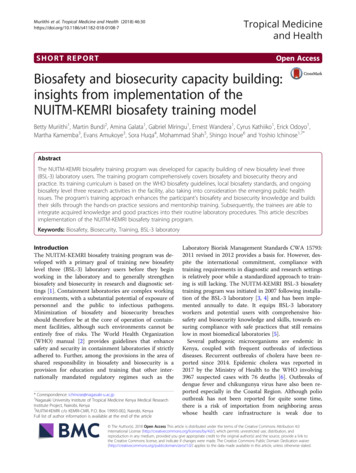
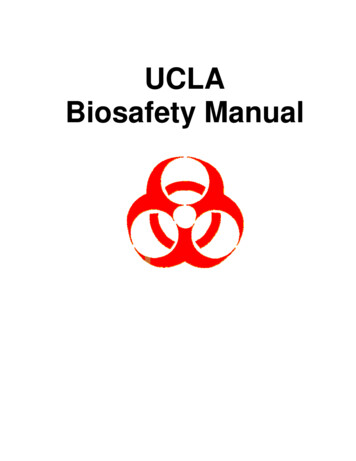
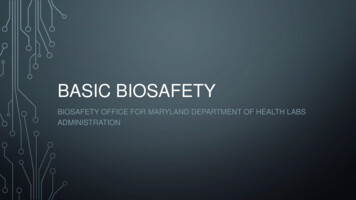
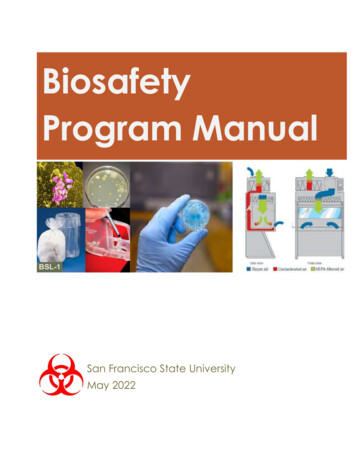
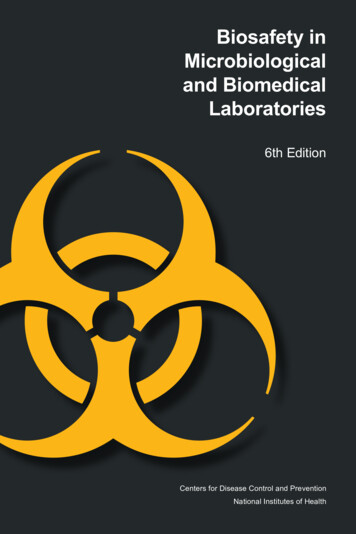
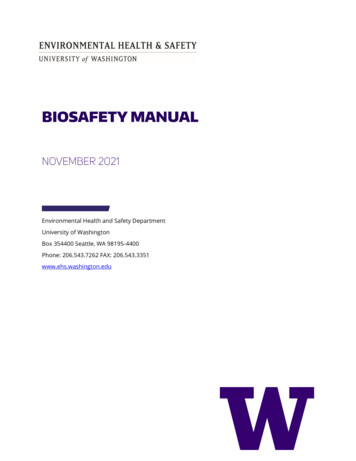
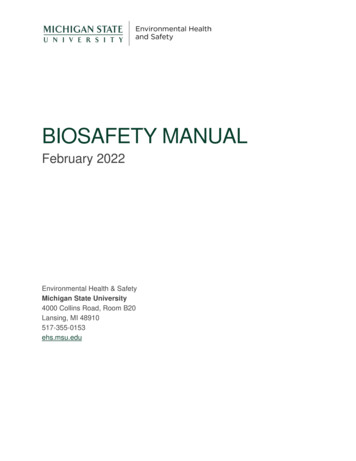
![Biosafety Manual University of Colorado Boulder 120621[80]](/img/25/biosafety-manual-university-of-colorado-boulder.jpg)
